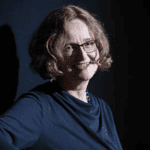Image courtesy of University of Edinburgh and Bennetts Associates. Photography by Keith Hunter.
On 29 October 1879, the new Royal Infirmary of Edinburgh building was officially opened on Lauriston Place. This beloved former hospital building is now home to the Edinburgh Futures Institute. Since data is one of the main themes of our work, that’s a good reason to consider the mathematical significance of the number 144.
What’s so interesting about 144? “That’s gross!” you might say. And it is, indeed, a large number.
It is, in fact, a gross, one of those specially named numbers which are multiples of twelve. They come from older number systems based on twelve, rather than the decimal system based on ten. 144 is the square of twelve, so a dozen dozen. It is a perfect square, mathematically speaking which means it is an integer which is the square of another integer.
The ceremonies in 1879 were presided over by the Lord Provost of Edinburgh and many dignitaries of the time were present. One data scientist who played a key role in the design of the Infirmary was Florence Nightingale. We don’t think she attended the opening ceremony, but she had visited Granton House in Edinburgh some years before in 1857. She was a guest of the chairman of the Board of Supervision and later advised on the building and layout of the Royal Infirmary building.
Florence Nightingale may be known to many as the famous nurse who ran hospitals in the Crimean War, but at the Edinburgh Futures Institute we celebrate her pioneering work with data. Florence Nightingale gathered data rigorously and developed innovative ways to present it, including her famous rose diagrams. This allowed her to understand a variety of problems such as infection rates. We take inspiration from her use of data as the basis for making a case to change public policy.
It is unclear if George Chrystal, Professor of Mathematics at the University in 1879, was invited to the attend the opening ceremony. Certainly today, mathematicians are central to the work of the Edinburgh Futures Institute. Colleagues from the Schools of Mathematics and Informatics developed the engaging set of courses focused on data and computing skills that are at the heart of modern applied mathematics, ensuring our MSc students have these as part of their core curriculum.
We also have wonderful partnerships and look forward to welcoming the Mathematics for Humanity project of the International Centre for Mathematical Sciences to our building. They seem strangely interested in the fact that the Royal Infirmary was founded in 1729, which is one more than 1728, a dozen dozen dozen (12 times 12 times 12). I’m afraid they will have to wait a while for the story of that year.
We don’t know if many of those present at the opening ceremony in 1879 will have been thinking about the building 144 years on. As an academic institute concerned with Futures, all our staff, students, and partners certainly think about the positive impact we hope to make on the world in future, whether in 12 months, 12 years or 144 years.
One of the ways we will mark the re-opening of our building is by creating a time capsule over the next year. We won’t bury this one in the ground, but we will use it to keep in touch with our building’s continuing story. I will do my very best to ask that our successors as custodians of the building open the time capsule in 144 years’ time.
I hope that when they open it on 29 October 2167, they will spend some time reflecting on the past, present and future of the building at that point. Along with other artifacts, they might find a copy of this article. Perhaps they too will then ponder the mathematical elegance and cultural significance of 144.
Further information
Edinburgh Futures Institute regularly sponsors activities of our local communities. On 23 November 2023 we are sponsoring a Co-creating with AI workshop at Push the Boat Out poetry festival. Register here.
Mathematics for Humanity Finds Home in the Edinburgh Futures Institute
Read more about Florence Nightingale’s visit to Granton on Curious Edinburgh and from Friends of the Granton Castle.
Read more about Florence Nightingale and what she did for Scotland






